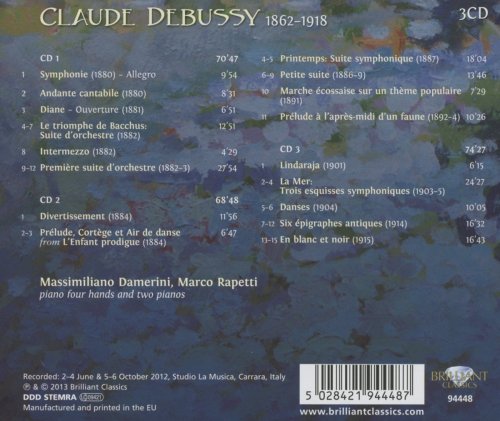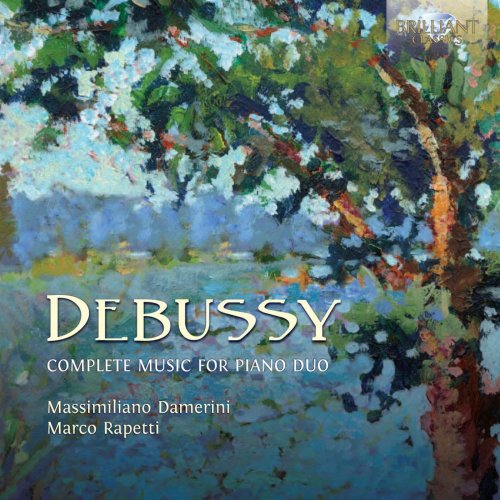
Marco Rapetti, Massimiliano Damerini - Debussy: Complete Music for Piano Duo (2013)
BAND/ARTIST: Marco Rapetti, Massimiliano Damerini
- Title: Debussy: Complete Music for Piano Duo
- Year Of Release: 2013
- Label: Brilliant Classics
- Genre: Classical Piano
- Quality: flac lossless (tracks)
- Total Time: 03:34:07
- Total Size: 649 mb
- WebSite: Album Preview
Tracklist
01. Symphonie for Piano Four Hands: Allegro
02. Andante cantabile for Piano Four Hands
03. Diane: Ouverture for Piano Four Hands
04. Le triomphe de Bacchus: Suite d'orchestre: I. Divertissement
05. Le triomphe de Bacchus: Suite d'orchestre: II. Andante
06. Le triomphe de Bacchus: Suite d'orchestre: IV. Marche et bacchanale: (Fragment A)
07. Le triomphe de Bacchus: Suite d'orchestre: IV. Marche et bacchanale: (Fragment B)
08. Intermezzo for Piano Four Hands
09. Première suite d'orchestre: I. Fête
10. Première suite d'orchestre: II. Ballet
11. Première suite d'orchestre: III. Rêve
12. Première suite d'orchestre: IV. Cortège et bacchanale
13. Divertissement for Two Pianos
14. L'enfant prodigue: Scène lyrique for Two Pianos, three excerpts: I. Prélude
15. L'enfant prodigue: Scène lyrique for Two Pianos, three excerpts: II. Cortège - III. Air de danse
16. Printemps: Suite symphonique for Piano Four Hands: I. Très modéré
17. Printemps: Suite symphonique for Piano Four Hands: II. Modéré
18. Petite suite for Piano Four Hands: I. En bateau
19. Petite suite for Piano Four Hands: II. Cortège
20. Petite suite for Piano Four Hands: III. Menuet
21. Petite suite for Piano Four Hands: IV. Ballet
22. Marche écossaise sur un thème populaire, for Piano Four Hands: 'The Earl of Ross March'
23. Prélude à laprès-midi dun faune
24. Lindaraja, for Two Pianos
25. La mer: Trois esquisses symphoniques, for Piano Four Hands: I. De l'aube à midi sur la mer
26. La mer: Trois esquisses symphoniques, for Piano Four Hands: II. Jeux de vagues
27. La mer: Trois esquisses symphoniques for Piano Four Hands: III. Dialogue du vent et de la mer
28. Danses, for Two Pianos: I. Danse sacrée
29. Danses, for Two Pianos: II. Danse profane
30. Six épigraphes antiques, for Piano Four Hands: I. Pour invoquer pan, dieu du vent d'été
31. Six épigraphes antiques, for Piano Four Hands: II. Pour un tombeau sans nom
32. Six épigraphes antiques, for Piano Four Hands: III. Pour que la nuit soit propice
33. Six épigraphes antiques, for Piano Four Hands: IV. Pour la danseuse aux crotales
34. Six épigraphes antiques, for Piano Four Hands: V. Pour l'égyptienne
35. Six épigraphes antiques, for Piano Four Hands: VI. Pour remercier la pluie au matin
36. En blanc et noir, for Two Pianos: I. Avec emportement
37. En blanc et noir, for Two Pianos: II. Lent, sombre
38. En blanc et noir, for Two Pianos: III. Scherzando

If it is true that the end of Romanticism coincided with the invention of electric light, then we can date this to 1880 – the year in which Thomas Alva Edison patented the light bulb. At around this time, a brilliant student at the Paris Conservatoire, Claude Debussy, decided to embark upon a composing career that would soon ‘illuminate’ the history of music.
Debussy’s output is roughly divided into three periods, each of which is represented by one of the three discs in this set. Focusing solely on his works for piano duo, the collection effectively represents a vantage point from which to analyse his stylistic development, since it touches on both Debussy's piano and orchestral writing simultaneously: as well as original keyboard works (Lindaraja is one example, the composer's first work inspired by Spain), there are piano pieces arranged for orchestra, vice-versa compositions (Prélude a l'après-midi d'un faune, for instance) and music that was clearly intended for the orchestra or for specific ensembles (one example is Le triomphe de Bacchus, for which the orchestration was never completed).
Performing these works are two of Italy's most celebrated pianists, Massimiliano Damerini and Marco Rapetti. Their accomplished readings highlight the unique relationship that exists between piano and orchestra – the former can be seen as a monochromatic version of the latter, with the latter essentially describing the former in polychromatic terms – and, at the same time, draw the listener's attention towards an important area of 19th-century music-making: namely piano transcriptions’ vital role in making operatic and symphonic repertoire available to all.
01. Symphonie for Piano Four Hands: Allegro
02. Andante cantabile for Piano Four Hands
03. Diane: Ouverture for Piano Four Hands
04. Le triomphe de Bacchus: Suite d'orchestre: I. Divertissement
05. Le triomphe de Bacchus: Suite d'orchestre: II. Andante
06. Le triomphe de Bacchus: Suite d'orchestre: IV. Marche et bacchanale: (Fragment A)
07. Le triomphe de Bacchus: Suite d'orchestre: IV. Marche et bacchanale: (Fragment B)
08. Intermezzo for Piano Four Hands
09. Première suite d'orchestre: I. Fête
10. Première suite d'orchestre: II. Ballet
11. Première suite d'orchestre: III. Rêve
12. Première suite d'orchestre: IV. Cortège et bacchanale
13. Divertissement for Two Pianos
14. L'enfant prodigue: Scène lyrique for Two Pianos, three excerpts: I. Prélude
15. L'enfant prodigue: Scène lyrique for Two Pianos, three excerpts: II. Cortège - III. Air de danse
16. Printemps: Suite symphonique for Piano Four Hands: I. Très modéré
17. Printemps: Suite symphonique for Piano Four Hands: II. Modéré
18. Petite suite for Piano Four Hands: I. En bateau
19. Petite suite for Piano Four Hands: II. Cortège
20. Petite suite for Piano Four Hands: III. Menuet
21. Petite suite for Piano Four Hands: IV. Ballet
22. Marche écossaise sur un thème populaire, for Piano Four Hands: 'The Earl of Ross March'
23. Prélude à laprès-midi dun faune
24. Lindaraja, for Two Pianos
25. La mer: Trois esquisses symphoniques, for Piano Four Hands: I. De l'aube à midi sur la mer
26. La mer: Trois esquisses symphoniques, for Piano Four Hands: II. Jeux de vagues
27. La mer: Trois esquisses symphoniques for Piano Four Hands: III. Dialogue du vent et de la mer
28. Danses, for Two Pianos: I. Danse sacrée
29. Danses, for Two Pianos: II. Danse profane
30. Six épigraphes antiques, for Piano Four Hands: I. Pour invoquer pan, dieu du vent d'été
31. Six épigraphes antiques, for Piano Four Hands: II. Pour un tombeau sans nom
32. Six épigraphes antiques, for Piano Four Hands: III. Pour que la nuit soit propice
33. Six épigraphes antiques, for Piano Four Hands: IV. Pour la danseuse aux crotales
34. Six épigraphes antiques, for Piano Four Hands: V. Pour l'égyptienne
35. Six épigraphes antiques, for Piano Four Hands: VI. Pour remercier la pluie au matin
36. En blanc et noir, for Two Pianos: I. Avec emportement
37. En blanc et noir, for Two Pianos: II. Lent, sombre
38. En blanc et noir, for Two Pianos: III. Scherzando

If it is true that the end of Romanticism coincided with the invention of electric light, then we can date this to 1880 – the year in which Thomas Alva Edison patented the light bulb. At around this time, a brilliant student at the Paris Conservatoire, Claude Debussy, decided to embark upon a composing career that would soon ‘illuminate’ the history of music.
Debussy’s output is roughly divided into three periods, each of which is represented by one of the three discs in this set. Focusing solely on his works for piano duo, the collection effectively represents a vantage point from which to analyse his stylistic development, since it touches on both Debussy's piano and orchestral writing simultaneously: as well as original keyboard works (Lindaraja is one example, the composer's first work inspired by Spain), there are piano pieces arranged for orchestra, vice-versa compositions (Prélude a l'après-midi d'un faune, for instance) and music that was clearly intended for the orchestra or for specific ensembles (one example is Le triomphe de Bacchus, for which the orchestration was never completed).
Performing these works are two of Italy's most celebrated pianists, Massimiliano Damerini and Marco Rapetti. Their accomplished readings highlight the unique relationship that exists between piano and orchestra – the former can be seen as a monochromatic version of the latter, with the latter essentially describing the former in polychromatic terms – and, at the same time, draw the listener's attention towards an important area of 19th-century music-making: namely piano transcriptions’ vital role in making operatic and symphonic repertoire available to all.
As a ISRA.CLOUD's PREMIUM member you will have the following benefits:
- Unlimited high speed downloads
- Download directly without waiting time
- Unlimited parallel downloads
- Support for download accelerators
- No advertising
- Resume broken downloads


